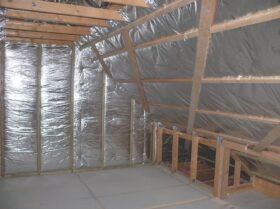The Significance of Multifoil Insulation in Loft Conversions
The Significance of Multifoil Insulation in Loft Conversions
Loft conversions have become a popular and efficient option for homeowners in the constantly changing field of home improvement. Converting your loft allows you to make the most of your available space by converting an unused attic into a useful and comfortable room, without having to spend a lot on construction or move to a new location. With the increasing demand for loft conversions, homeowners are now exploring new ways to make these renovations not just visually appealing but also energy-efficient and environmentally friendly. This article will delve into the significance of Multifoil Insulation in loft Conversions.
Loft Conversion Insulation
Effective insulation is an essential aspect of a loft conversion, as it plays a vital role in regulating the temperature. Apart from providing thermal comfort, proper insulation also leads to considerable energy conservation by reducing the burden on heating systems.
In the past, loft insulation has been dependent on materials like fibreglass and mineral wool, which can be successful but have some downsides, such as potential health hazards and reduced thermal efficiency as they degrade. On the other hand, multifoil insulation presents a more advanced option that tackles these issues while providing excellent insulation capabilities.
The use of Multifoil Insulation will help obtain a U-value of 0.15, which is the current requirement for meeting Building Regulations.
Multifoil Insulation
Multifoil Insulation is an incredibly adequate and inventive insulation option, which combines several layers of reflective foil and insulating material. This distinctive combination forms a barrier that successfully reflects radiant heat, also reducing heat transfer and improving thermal effectiveness.
Multifoil Insulation differs from traditional insulation materials in that it does not depend solely on trapping air pockets for insulation. Instead, it utilises the reflective properties of foil to redirect heat back toward its origin, thus maintaining the desired temperature in the loft area.
At Multifoils Direct, we have developed the TrioQuilt 0.15 Roof Insulation System. In response to the government’s updated recommendations for the U-value of 0.15 for flat and pitched roofs under the Part L Building Regulations. This change has made it more challenging to meet the required U-value. Resulting in higher costs and occupy more space for insulation.
The TrioQuilt system, available on the website, is composed of three parts: two layers of YBS SuperQuilt as well as a layer of EcoLoft Non-Itch. By using this system, a U-value of 0.15 can be achieved. Which is the standard U-value needed for renovation and expansion projects in the UK from 2022 onward.
Conclusion
With the increasing demand for environmentally friendly and energy-efficient living options, Multifoil Insulation has emerged as a revolutionary solution for loft conversions. Its impressive ability to provide thermal insulation, adaptability, and also affordability. Make it a desirable option for homeowners looking to utilise their space to the fullest while also reducing environmental impact.
To obtain further details about Multifoil Insulation, please request a callback from one of our specialists HERE.

 Fast Next Working Day Delivery
Fast Next Working Day Delivery Bulk Discounts Available
Bulk Discounts Available Order Pre 2pm for Delivery
Order Pre 2pm for Delivery 
